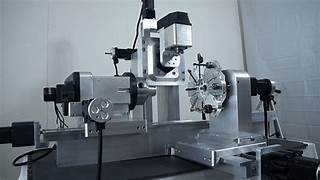Rapid prototyping machines, also known as 3D printers, have been making waves in the world of product design. These machines have the ability to create physical models of products quickly and cost-effectively, allowing designers to iterate on their designs at a much faster pace than traditional methods. In this article, we will explore how rapid prototyping machines are changing the game in product design.
What is Rapid Prototyping?
Rapid prototyping is a process that involves the quick creation of physical prototypes of a product using 3D printing technology. This technology allows designers to turn their digital designs into tangible objects in a matter of hours, rather than weeks or months. Rapid prototyping machines build up the physical model layer by layer, based on a digital 3D model, using materials such as plastics, resins, or metals.
The Benefits of Rapid Prototyping
There are several benefits to using rapid prototyping machines in product design. One of the main advantages is the speed at which prototypes can be produced. Traditional prototyping methods, such as CNC machining or injection molding, can take weeks to produce a single prototype. With rapid prototyping machines, designers can have a physical model in their hands within a matter of hours.
This rapid turnaround time allows for quicker iterations and modifications to the design, ultimately speeding up the product development process. A rapid prototyping machine can be less expensive for small production runs as it doesn’t need the expensive tooling that conventional methods contain. This enables designers to test multiple design concepts without breaking the budget.
Another benefit is the ability to create complex geometries and intricate designs that may be challenging or impossible to produce using traditional methods. Overall, the use of rapid prototyping machines in product design can lead to faster development cycles, lower costs, and more innovative final products.
Iterative Design Process
Rapid prototyping machines have revolutionized the iterative design process. Designers can quickly create multiple versions of a product and test them out to see which design works best. This rapid iteration allows designers to make improvements on the fly and test out new ideas without the time and cost constraints of traditional prototyping methods.
Rapid prototyping machines have changed the game when it comes to the design process. Designers are now able to swiftly produce various versions of a product and evaluate them to determine the most effective design. This rapid iteration process enables designers to make immediate enhancements and experiment with new ideas without being limited by the time and financial constraints of conventional prototyping techniques.
Cost-Effective Prototyping
Another major benefit of rapid prototyping machines is cost-effectiveness. Traditional prototyping methods can be expensive, especially when creating multiple iterations of a design. Rapid prototyping machines use materials efficiently, reducing waste and overall costs. This makes it more affordable for designers to create multiple prototypes and explore different design options.
Complex Geometries and Customization
Rapid prototyping machines are capable of creating complex geometries that would be difficult or impossible to achieve with traditional manufacturing methods. This allows designers to create intricate and unique designs that push the boundaries of what is possible. In addition, rapid prototyping machines allow for customization, enabling designers to tailor products to specific needs or preferences.
Reduced Time to Market
By speeding up the prototyping process, rapid prototyping machines help reduce the time to market for new products. Designers can quickly iterate on their designs, test them out, and make improvements before moving into full-scale production. This accelerated timeline gives companies a competitive edge by bringing products to market faster than ever before.
Rapid prototyping machines are invaluable tools for designers and manufacturers looking to streamline their product development process. With the ability to quickly create physical prototypes based on digital designs, these machines allow for rapid iteration and testing of new ideas. This speed and efficiency in prototyping ultimately lead to faster product development cycles and reduced time to market for new products.
Overall, rapid prototyping machines are a game-changer for businesses looking to stay ahead in today’s fast-paced market. By enabling designers to quickly bring their ideas to life and test them out in the real world, these machines are a key factor in reducing time to market and ultimately giving companies a competitive edge in the industry.
Applications of Rapid Prototyping
Rapid prototyping machines have a wide range of applications across various industries. In product design, rapid prototyping is commonly used to create visual models for concept validation, functional prototypes for testing, and even end-use parts for production. Industries such as automotive, aerospace, healthcare, and consumer goods are increasingly turning to rapid prototyping to streamline their design processes.
Rapid prototyping machines are also utilized in the medical field for creating customized implants and prosthetics. In the architecture and construction industry, these machines are used to produce detailed scale models and prototypes of structures. The entertainment industry also benefits from rapid prototyping for creating props, costumes, and set designs. Overall, rapid prototyping technology has revolutionized the way products are designed, tested, and manufactured in various sectors, leading to faster innovation and cost-effective production.
Future Trends in Rapid Prototyping
As technology continues to advance, the future of rapid prototyping looks promising. Innovations in materials, such as new composites and metals, are expanding the capabilities of rapid prototyping machines. Additionally, advancements in software are making it easier for designers to create complex designs and simulate real-world conditions. With these developments, rapid prototyping is set to continue revolutionizing product design in the years to come.
As technology continues to advance, the future of rapid prototyping looks promising. Innovations in materials, such as new composites and metals, are expanding the capabilities of rapid prototyping machines. Additionally, advancements in software are making it easier for designers to create complex designs and simulate real-world conditions.
With these developments, rapid prototyping is set to continue revolutionizing product design in the years to come. The ability to quickly iterate on designs, test functionality, and produce prototypes with high precision and accuracy will greatly benefit industries such as aerospace, automotive, healthcare, and consumer goods. The future of rapid prototyping holds great potential for speeding up the product development process, reducing costs, and ultimately bringing innovative products to market faster than ever before.
Conclusion
Rapid prototyping machines are revolutionizing product design by enabling designers to create physical prototypes quickly, cost-effectively, and with great complexity. The speed, cost-effectiveness, and customization capabilities of rapid prototyping machines are transforming the way products are designed and developed. As technology continues to evolve, rapid prototyping will play an increasingly important role in bringing innovative products to market faster than ever before.



